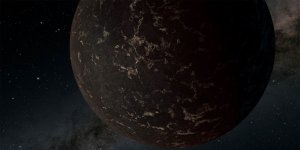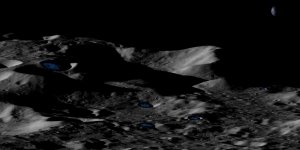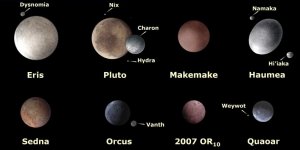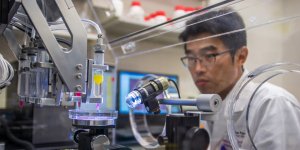Space News

A new study indicates that some exoplanets may have better conditions for life to thrive than Earth itself has. »

A new study using data from NASA's Spitzer Space Telescope provides a rare glimpse of conditions on the surface of a rocky planet orbiting a star beyond the Sun. »

Earth’s Moon and Mercury, the closest planet to the Sun, may contain significantly more water ice than previously thought, according to a new analysis. »

A piping hot planet discovered by NASA’s Transiting Exoplanet Survey Satellite (TESS) has pointed the way to additional worlds orbiting the same star, one of which is located in the star’s habitable zone. If made of rock, this planet may be around twice Earth’s size. »

Observations by NASA's Hubble Space Telescope reveal magnesium and iron gas streaming from the strange world outside our solar system known as WASP-121b. »

The first known interstellar object to visit our solar system was discovered on Oct. 19, 2017, by the Panoramic Survey Telescope and Rapid Response System 1 Telescope located at the University of Hawaii’s Haleakala Observatory. »

New data from the Keck Observatory show gas directly spiraling into growing galaxies. »

As if black holes weren't mysterious enough, astronomers using NASA's Hubble Space Telescope have found an unexpected thin disk of material furiously whirling around a supermassive black hole at the heart of the magnificent spiral galaxy NGC 3147, located 130 million light-years away. »

Two NASA space telescopes have teamed up to identify, for the first time, the detailed chemical "fingerprint" of a planet between the sizes of Earth and Neptune. No planets like this can be found in our own solar system, but they are common around other stars. »

This week, NASA's Curiosity Mars rover found a surprising result: the largest amount of methane ever measured during the mission - about 21 parts per billion units by volume (ppbv). One ppbv means that if you take a volume of air on Mars, one billionth of the volume of air is methane. »

Science, Space, News.
An oxygen generator is designed to convert carbon dioxide into breathable oxygen. »

Curiosity rover has confirmed that the region on Mars it's exploring, called the "clay-bearing unit," is well deserving of its name. »

An international group of astronomers has identified a rogue planet orbiting its star in the so-called Neptunian Desert. »

German Planetologists showed for the first time, that water came to Earth with the formation of the Moon some 4.4 billion years ago. »

NASA's Juno mission to Jupiter made the first definitive detection beyond our world of an internal magnetic field that changes over time, a phenomenon called secular variation. Juno determined the gas giant's secular variation is most likely driven by the planet's deep atmospheric winds. »

A survey of more than 12,000 images reveals that at least one lunar mare has been cracking and shifting as much as other parts of the Moon - and may even be doing so today. The study adds to a growing understanding that the Moon is an actively changing world. »

The Event Horizon Telescope unveiled the first-ever image of a black hole's event horizon, the area beyond which light cannot escape the immense gravity of the black hole. That giant black hole, with a mass of 6.5 billion Suns, is located in the elliptical galaxy Messier 87. »

NASA's Mars InSight lander has measured and recorded for the first time ever a likely "marsquake." »

Scientists from NASA’s Goddard Space Flight Center in Greenbelt, Maryland have found evidence that Mercury’s inner core is indeed solid and that it is very nearly the same size as Earth’s inner core. »

On its final flyby of Saturn's largest moon, NASA's Cassini spacecraft gathered radar data revealing that the small liquid lakes in Titan's northern hemisphere are surprisingly deep, perched atop hills and filled with methane. »

Researchers from NASA and the Johns Hopkins University Applied Physics Laboratory in Laurel, Maryland, report that streams of meteoroids striking the Moon infuse the thin lunar atmosphere with a short-lived water vapor. »

New Earth-based telescope observations show that auroras at Jupiter's poles are heating the planet's atmosphere to a greater depth than previously thought - and that it is a rapid response to the solar wind. »

New findings have emerged about five tiny moons nestled in and near Saturn's rings. The closest-ever flybys by NASA's Cassini spacecraft reveal that the surfaces of these unusual moons are covered with material from the planet's rings - and from icy particles blasting out of Saturn's larger moon Enceladus. »

A new study reveals asteroid impacts on ancient Mars could have produced key ingredients for life if the Martian atmosphere was rich in hydrogen. An early hydrogen-rich atmosphere on Mars could also explain how the planet remained habitable after its atmosphere thinned. »

The GRAVITY instrument on ESO’s Very Large Telescope Interferometer has made the first direct observation of an exoplanet using optical interferometry. This method revealed a complex exoplanetary atmosphere with clouds of iron and silicates swirling in a planet-wide storm. »

A NASA spacecraft that will return a sample of a near-Earth asteroid named Bennu to Earth in 2023 made the first-ever close-up observations of particle plumes erupting from an asteroid’s surface. Bennu also revealed itself to be more rugged than expected, challenging the mission team to alter its flight and sample collection plans, due to the rough terrain. »

The Cigar Galaxy is famous for its extraordinary speed in making new stars, with stars being born 10 times faster than in the Milky Way. Now, data from the Stratospheric Observatory for Infrared Astronomy have been used to study this galaxy in greater detail, revealing how material that affects the evolution of galaxies may get into intergalactic space. »

Every object, planet or person traveling through space has to contend with the Sun's damaging radiation — and the Moon has the scars to prove it. »

After several years of analysis, a team of planetary scientists using NASA's Hubble Space Telescope has at last come up with an explanation for a mysterious moon around Neptune that they discovered with Hubble in 2013, "the moon that shouldn't be there." »

A NASA glaciologist has discovered a possible second impact crater buried under more than a mile of ice in northwest Greenland. »

During its routine yearly monitoring of the weather on our solar system's outer planets, NASA's Hubble Space Telescope has uncovered a new mysterious dark storm on Neptune and provided a fresh look at a long-lived storm circling around the north polar region on Uranus. »

The rough-and-tumble environment near the center of the massive Coma galaxy cluster is no match for a wayward spiral galaxy. New images from NASA's Hubble Space Telescope show a spiral galaxy being stripped of its gas as it plunges toward the cluster’s center. »

The number of asteroid impacts to the Moon and Earth increased by two to three times starting around 290 million years ago. »

The strange orbits of some objects in the farthest reaches of our solar system, hypothesised by some astronomers to be shaped by an unknown ninth planet, can instead be explained by the combined gravitational force of small objects orbiting the Sun beyond Neptune. »



